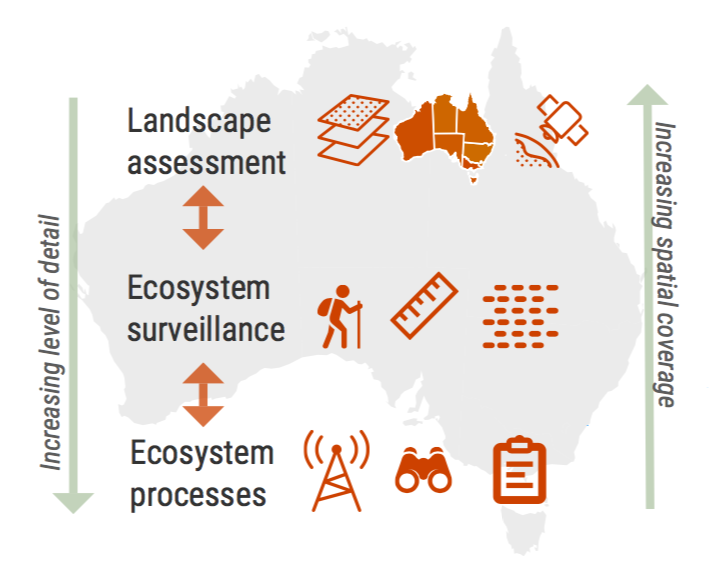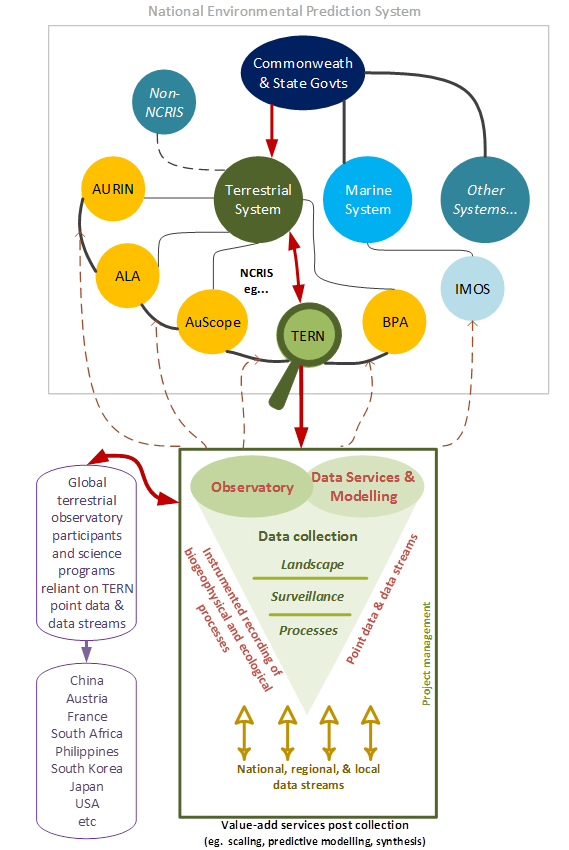Transitioning TERN to better meet user needs

TERN is making some changes to its land observatory. We are re-shaping our structure to place more importance on the way in which data derived from the local, regional and continental scale facilities is integrated and made more accessible for your research on variation and change of terrestrial ecosystems in Australia.
- Landscape assessment is delivered primarily by AusCover’s remote-sensing data streams from technologies which include satellite and airborne platforms operating on a continental scale. Such data streams are used to characterise and detect change relating to vegetation structure and composition, land cover underlying forces, and bushfire dynamics and impacts. Soil and Landscape Grid of Australia products are included in this capability.
- Ecosystem surveillance occurs at a regional scale and requires field sampling across a network of hundreds of plots at different scales from the AusPlots and Australian Transect Network respectively. Standard methodologies for collecting core attributes are used across time and space to detect and quantify change over large areas in vegetation structure and composition, land cover and soil characteristics.
- Ecosystem processes data are derived from in-situ sensors operated continuously at a local scale. OzFlux’s towers measure gas exchange between the ecosystem and atmosphere and such measures are integrated with detailed field observations of vegetation and soils from a grid of 12 intensive SuperSites such that measures and observations of the drivers of change in ecosystems are made possible.
TERN’s position within the national environmental research infrastructure system (below), which demonstrates how TERN infrastructure integrates a field observatory (above) with an ecosystem data services and modelling capability. The former collects data and generates data products to understand processes and changes in biodiversity, carbon and land cover and the latter aggregates TERN and other data, enabling these data to be consumed by a wide range of users.
This evolution in TERN’s structure doesn’t change our key purpose of providing researchers, government and industry with open access to the infrastructure and associated long-term data needed for measuring and observing changes in terrestrial ecosystems. We continue to deliver this essential service within Australia’s national research infrastructure program, while also making some changes to ensure TERN is meeting the needs of a future environmental prediction system as envisioned in the 2016 National Research Infrastructure Roadmap.
The TERN Advisory Board, having critically assessed TERN’s capability, has endorsed these changes to ensure TERN’s resources are deployed most effectively to meet the data needs of Australian and global research partners. With greater internal coherency among its data-generating infrastructure components, coupled with a centralised and accessible repository of data and data services, TERN is increasing its global recognition as Australia’s terrestrial ecosystem observatory.
In light of its restricted budget, planning a more streamlined TERN structure meant difficult decisions from management and TERN’s Advisory Board. Not all of TERN-supported facilities transition into the integrated and refined TERN on 1 January 2018. Indeed, given the 2016 NCRIS Roadmap, the TERN Advisory Board believes not all components of TERN’s infrastructure (operating up until the end of the NCRIS 2016 grant) continue to meet the requirements of national infrastructure or of a national integrated environmental prediction system. Components no longer included in the revised TERN structure are being assisted to either merge with other TERN services, transition back into their host institutions or decommission.
With these changes, TERN is now poised to deliver a more comprehensive service from an integrated set of infrastructure which can better meet a wide range of users’ needs. Part of this maturing process has seen TERN, in regular meetings with its cognate NCRIS projects, planning an optimisation of those aspects which are synergistic, and planning communication which succinctly highlights the distinct functions of technology platforms within the ongoing NCRIS Program.
While TERN’s immediate priority is consolidation of the refined field observatory structure and centralised data repository, we will continue to build relationships with our Australian and global research infrastructure partners for ongoing enhancement of our services and impact.
Have your say on the future of TERN
Would you like to have a say in the further shaping of TERN’s infrastructure and data streams? TERN is currently seeking feedback from the ecosystem science community to help it identify priorities for the future and to ensure our services meet your needs.
If you’d like to contribute to this process please take the short (5-10 min) survey here.
Your responses are anonymous and will be invaluable for us in planning for the future and guiding the next phase of TERN’s development.
The survey closes on Sunday 31 December 2017 at midnight.
Original article posted on TERN, 26 November 2017 (link)


